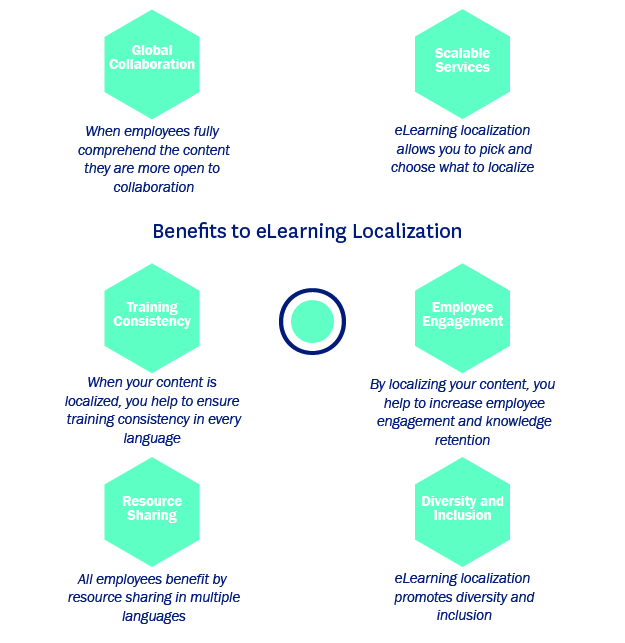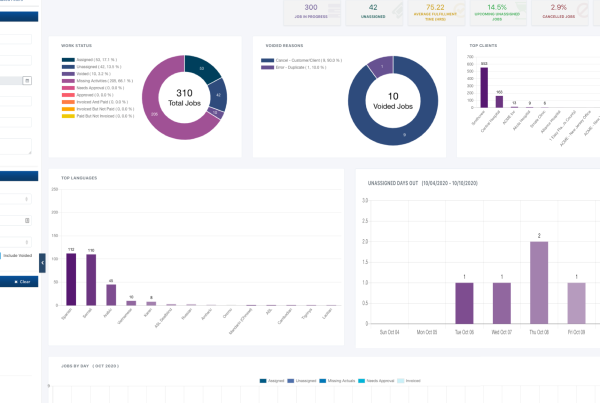Benefits of eLearning
We know how busy you are so there is no sense in beating around the bush. Let’s get right down to brass tacks and talk about the future shift to eLearning. In fact, it isn’t really a “future” shift at all. It is happening right before our very eyes. And, although the COVID-19 pandemic was certainly not the catalyst for this shift, it most definitely sped up the process. But why? Why are so many companies across industries moving toward eLearning? Read on to learn the impressive benefits that eLearning offers you and your stakeholders.
- Personalization
The very nature of the eLearning experience allows students to customize their learning progress. eLearning allows students, for instance, to set their own goals and seamlessly communicate with instructors at the most convenient time for them. We all live busy lives, so the idea behind creating a personalized approach to learning is to meet the unique needs of each student — personalization is one of the greatest benefits to eLearning.
- Self-paced Instruction
Part and parcel with personalization is the ability to set an instructional pace that works for each student. Self-paced instruction in eLearning allows students to set the duration of each eLearning session, schedule sessions according to their availability, and control the amount of learning material they consume with each session. Often, when students have more control over the learning process, retention rates also increase, adding to the attractiveness of this approach to learning and development. In fact, according to LinkedIn Learning:
- 68% of employees prefer to learn at work
- 58% of employees prefer to learn at their own pace
- 49% of employees prefer to learn at their own point of need
Lesser Logistics
For multinational corporations (MNCs), the logistics behind organizing training and development courses can become quite daunting. We need to consider each student’s respective time zone, for one, as well as their availability and their preferred language. Who will teach the courses? In which language/s will instruction be delivered? Where will the instructors and students stay? What equipment is necessary for instruction? Do we have the budget to manage it all?
But you don’t have to be leading an MNC to experience the frustration of organizing and managing training and development programs. Even small organizations run into significant challenges when it comes to coordinating all the factors that must tie into successful training and development workshops. However, with eLearning, the logistics is much simpler. There is no need, for instance, to coordinate lodgings, meal allowances, instructor availability and accommodations, among a myriad of logistical planning.
- Cost Savings
Expanding on “lesser logistics” is the significant cost savings companies (and students) experience by investing in eLearning programs. Again, eLearning removes the need to travel. Therefore, there is no need to book lodgings, no need to budget for three meals a day, no need to purchase potentially expensive equipment, and no need to coordinate the accommodations of the instructor/s. Simply put, eLearning programs save everyone time and money.
- Audio, Video, Text, Animations — and even Testing Capabilities
There is little argument that in-person instruction is arguably the most effective teaching method. However, eLearning is becoming a wonderful alternative and the next-best-thing to being physically present with instructors and fellow students. The audio, video, and animation capabilities of most eLearning platforms help to increase engagement and inject “life” into an otherwise lonely self-guided learning process. When students can hear and see what is going on, they feel more connected to the learning experience.
eLearning systems also have the ability to offer quizzes along the way that check for progress, retention, and overall understanding. Instead of you or the students wondering how much they have learned, they can test themselves, repeat lessons if the quiz reveals a low retention score, or move to advanced lessons if test results show full comprehension.
- Independence
But perhaps the greatest benefit of all is the sense of independence eLearning offers each student. eLearning is a convenient, cost-effective solution to continue the learning process. Its general ease of use and high-level of accessibility creates the perfect alternative to in-person instruction. However, this sense of independence can be greatly and negatively impacted if the instruction is delivered in a language some students do not understand — or at the very least, do not understand well enough.
In order to address this challenge head on, companies in a growing number of industries are investing in eLearning localization. Did you know that by the year 2030, the global workforce is expected to reach 3.5 billion people? And that is precisely where the magic of eLearning localization takes center stage. Organizations both large and small require localization services so that their online content is accessible to all internal stakeholders, partners, resellers, and clients regardless of the language they speak.
Benefits to eLearning Localization
Has your company already moved, at least in part, to eLearning platforms for training, resource sharing, and ongoing collaboration? Chances are, the answer is yes. Perhaps one of the greatest changes to which we have all been witness over this past year is the increasing shift to eLearning platforms. In order to continue engaging remote employees, eLearning is making a powerful impact across industries — and so is eLearning localization. So, just what are some of the benefits companies and employees enjoy through eLearning localization? We’re glad you asked!
How eLearning Localization Enhances Employee Training
eLearning as a stand-alone service helps companies to engage with their global audience. But when you invest in eLearning localization, your employees’ collective experience is enhanced even further. How? eLearning localization adapts all content (including graphics, images, and messaging) to each recipient’s preferred language and culture. Think of it as creating content that will look and feel as though it were developed specifically for each recipient. Not only does this help to engage your global employees, but it also helps them to better retain the information you are sharing, and encourages everyone to become actively involved in the learning process.
By localizing your eLearning programs, you effectively remove linguistic and cultural barriers that are often present with traditional eLearning approaches. Localization also ensures consistency across the board so that all employees — regardless of their respective language or culture — receive the very same effective messaging and instructional content. When your eLearning courses promote a sense of diversity and inclusion, everyone benefits.
The Future is in eLearning Localization
The business world has increased its adoption of remote working environments. In fact, even once COVID-19 is well under control (and even better, in the rearview mirror), remote working options for employees will likely remain the reality for the foreseeable future. And, with an increasingly global workforce, eLearning localization will also likely continue to grow in demand.
In fact, according to the Chief Learning Officer, a digital platform for learning and development (L&D) professionals, “it seems that the pandemic has accelerated the adoption of trends already in place — most notably, e-learning delivery.”1
To put this into even greater perspective, the Chief Learning Officer found in a recent survey that, although the adoption of eLearning among L&D leaders has been trending upward for a number of years, there was a markedly sharp increase from 2019 to 2020.
Data Source: Chief Learning Officer
In fact, the same survey found that well over 50 percent of L&D leaders expected a variety of eLearning approaches to increase over the next 12 – 18 months.
Is Your eLearning Material Localization Ready?
Although traditional face-to-face learning modes are likely to return to a certain degree once the pandemic is a distant memory, it is likely that, given the paradigm shift in the minds of employees and industry leaders, eLearning is here for the long run. Is your eLearning material localized and ready for your global audience?
Propio has extensive experience localizing content across websites, mobile, multimedia, software, eLearning environments, and more. We support a variety of eLearning technologies and are happy to deliver a fully localized course in any format (including SCORM package). Propio also has its own Learning Management System (LMS) allowing us to host and manage eLearning courses on behalf of our clients. With a skilled technical team, Propio can partner with you at every stage of your eLearning development process, from the early design phase to full implementation. Not only do we seamlessly work across technology platforms to offer voice-over, video captioning, and overall production assistance but we’ll ensure a thorough review of each product for native language and cultural cues.
When you partner with Propio, rest assured that your content, graphics, animations, and subjects are appropriate for your intended audience. Connect with us today, and we’ll help you and your employees to be heard and understood.
REFERENCES
1 John, Ashley St. “The Rise of e-Learning.” Chief Learning Officer – CLO Media, 17 July 2020, www.chieflearningofficer.com/2020/07/17/the-rise-of-e-learning/.
In addition to:
“Elearning for Employee Engagement & Retention: LinkedIn Learning.” Elearning for Employee Engagement & Retention | LinkedIn Learning, learning.linkedin.com/resources/workplace-learning-report-2018/workplace-learning-trends-for-employees.
Dobbs, Richard, et al. “The World at Work: Jobs, Pay, and Skills for 3.5 Billion People.” McKinsey & Company, McKinsey & Company, 21 May 2019, www.mckinsey.com/featured-insights/employment-and-growth/the-world-at-work.











